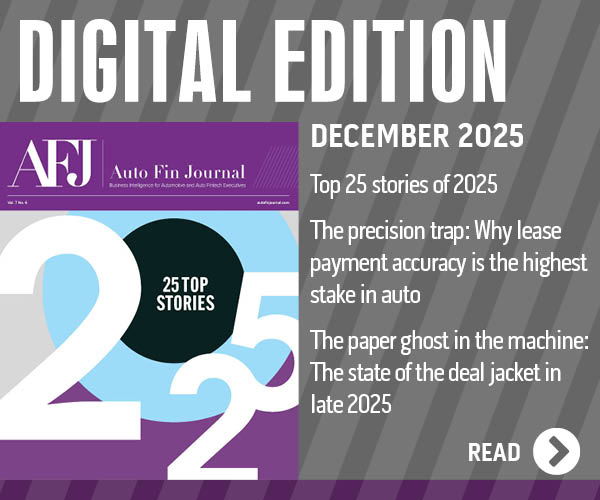COMMENTARY: Guide to tracking today’s virtual auto lending trends into 2021

By subscribing, you agree to receive communications from Auto Remarketing and our partners in accordance with our Privacy Policy. We may share your information with select partners and sponsors who may contact you about their products and services. You may unsubscribe at any time.
NORTH HILLS, N.Y. –
For many of us, it feels like 2021 cannot get here soon enough. While we all are ready for a fresh slate, a robust end-of-year auto lending strategy to close out 2020 on a high note and enter 2021 on the right footing will be essential to setting your business up for success in the months to come.
And with 76% of consumers open to the idea of buying a vehicle 100% online, it is no surprise that lenders will need to continue to position themselves to support digital transactions without letting compliance fall by the wayside.
However, the landscape is changing at a record pace and today’s news is quickly becoming tomorrow’s history. To get ahead and stay ahead of the pack going into 2021 and beyond, lenders will need to make sure they are evolving their business strategies to account for the following three virtual auto lending trends.
1. New Security Measures for a Digital World
According to the 2020 Cox Automotive COVID-19 Digital Shopping Study, consumer likelihood to apply for a car loan or get financing online has risen by 30% post-COVID. And that was from May. The growing adoption of remote signing and delivery technology since then has likely pushed this number even higher. But as more dealerships and lenders strive to deliver on a purely digital F&I process, identity fraud and compliance concerns have also risen. And it’s easy to understand why. Will dealerships be able to keep up with anti-fraud and compliance measures online and remotely? How will responsibility for verifying identities shift between the dealer and lender in a virtual environment? The questions go on.
Ultimately, the truth is that there are scammers out there looking to take advantage of the current situation and digital migration. It will be on both the dealer and the lender to stay vigilant and diligently run OFAC checks and Red Flag alerts. Lenders should also be leveraging structured stipulations as a tool to, in part, confirm the legitimacy of a customer’s identity before a deal is executed. On the other side, these stipulations can help dealership staff better communicate which documents a customer will need for the funding process.
Lastly, it is also important to remember that even once a contract is signed, compliance concerns remain. Take same-day delivery as an example. If the customer signs the contract prior to delivery, they will start to accrue interest before they even own the car. Because dealerships are typically unable to pre-date contracts, they have a responsibility to ensure delivery the same day as signing. Lenders should therefore make sure to work closely with their dealer partners to guarantee a seamless same-day delivery process.
Subscribe to Auto Remarketing to stay informed and stay ahead.
By subscribing, you agree to receive communications from Auto Remarketing and our partners in accordance with our Privacy Policy. We may share your information with select partners and sponsors who may contact you about their products and services. You may unsubscribe at any time.
2. Automating the Funding Process
Many lenders are fast-tracking their digital transformation and adjusting business processes to do what is necessary to remain competitive, profitable and efficient in the current economy. Several OEMs have followed suit as well, partnering with their captive finance arms and franchise dealers to go more digital, with some even charging dealerships a fee for using a paper contract.
We as an industry must continue to make progress toward the larger goal of a fully automated funding process. In a shrinking economy, dealers and lenders must be as effective as possible in their margins. By pushing more data into the loan origination system, an automated funding process leads to increased capacity and fewer errors, enabling lenders to provide a higher level of service and move contracts more efficiently. In fact, Dealertrack is seeing a less than 1% return rate on digital contracts.
When the funding process can be done in a systematic, automated fashion, you eliminate the need for the lender to review every nook and cranny of a contract. Instead, they will be able to quickly eye a contract and move it forward to funding. Key areas where automation can be applied to ‘perfect’ the contract funding process and eliminate the time-consuming tasks that come with manual data entry and validation include:
• The collection, preparation and verification of the contract data
• The digitization of all ancillary documents, such as extended service contracts and GAP insurance, to guarantee all data is accurate and everything has been signed
• The verification of all stipulations and loan collateral
3. A Shift in the Auto Lending Dynamic
The rising popularity and necessity of digital retailing is fundamentally changing where consumers are completing credit applications. This used to be done exclusively in-store at the dealership but now it is increasingly done online elsewhere. As a result, the way dealers and lenders work together has also shifted. How exactly? Well, traditionally consumers found a car to buy at a dealership and the dealership helped them find lending options. Today, lenders are working harder to retain more of their customers by pre-approving them for auto financing first and then directing them to the dealership. Consequently, what was once a linear relationship between the dealership and lender has now become a triangle between the dealer, lender and consumer. The new dynamic requires all three parties to partner together for a successful transaction.
As lenders today look to engage with car buyers earlier in the process in an effort to pre-approve them for auto financing, they are also delivering a value-added service for their dealer partners. This shifting dynamic also requires dealers to leverage a deeper pool of lenders and credit unions.
Embracing this changing landscape and adapting business strategies accordingly will ultimately lead to an improved, symbiotic relationship between lenders and their dealer partners — the result being more originations for the lender and more sales for the dealership.
There is no getting around the facts. Yes, the SAAR is forecasted to be down for 2020, but U.S. auto sales have proven to be nothing short of resilient. That means there are still originations to be had this year. However, with fewer originations to go around overall, lenders will be competing at the service level to come out on top. Those who are closely tracking virtual auto lending trends and using them to shape their business strategies will be best positioned for success when the new year comes ringing.
Andy Mayers is a lender solutions strategist at Dealertrack.


